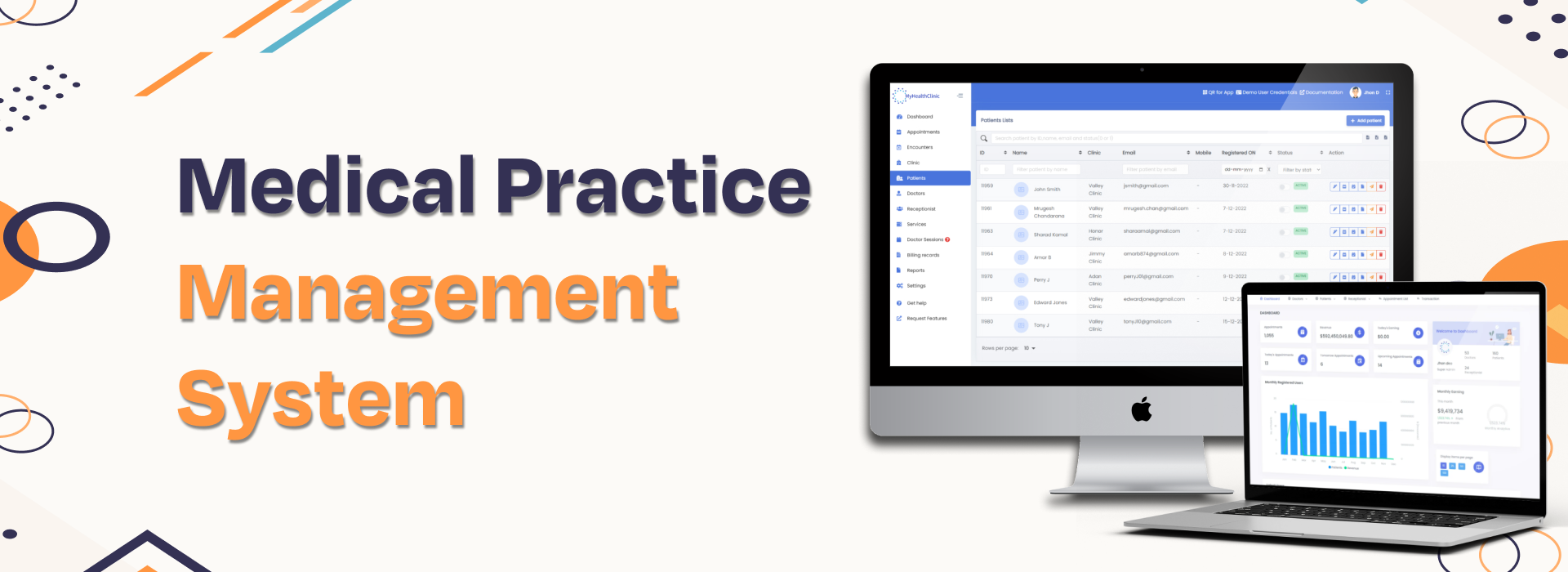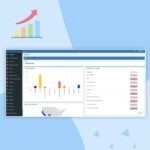Medical Practice Management System

About Client
Industry
Healthcare
Location
USA
Project Overview
Our client, a healthcare provider, struggled with fragmented systems that made it difficult to manage clinical, administrative, and financial tasks efficiently. Manual appointment scheduling, scattered patient records, and lack of telehealth support were slowing down operations. They also needed a secure, scalable solution that could streamline workflows, enable remote consultations, and improve the overall patient experience.
To overcome these challenges, we built a cloud-based SaaS product – Medical Practice Management System that unifies patient records, scheduling, billing, telehealth, and workflow automation. The platform reduces manual workload with automated appointment handling, real-time availability tracking, and digital invoicing. Doctors and staff can securely manage patient data, track treatments, and generate documentation with ease.
The system supports video-based teleconsultations, digital prescriptions, and QR-based profile access for better remote engagement. Financial operations are simplified through automated billing and subscription management. A built-in analytics dashboard offers insights into appointments, billing, and patient activity. With HIPAA-compliant security, the platform ensures complete data protection while modernizing healthcare operations.
Traditional Process
Prior to adopting the custom Medical Practice Management System, the client operated using outdated and disconnected methods that were no longer suitable for a modern healthcare environment. Their workflow included:
01
Manual Appointment Scheduling
Patients had to either call the clinic or visit in person to schedule an appointment. The clinic staff would then record the appointment using a notebook, register, or Excel sheet. There was no digital calendar or software that could track real-time availability of doctors. As a result, scheduling was slow and often inaccurate.
02
Paper-Based and Isolated Patient Records
Each department or doctor maintained their own records, either on paper or in individual software systems that were not connected to each other. This meant a patient’s full medical history was never in one place. If a doctor needed information from another department, it had to be retrieved manually or requested again from the patient.
03
In-Person Consultations Only
Patients were required to physically visit the clinic for every consultation. There was no option for video consultations or remote diagnosis. This made it difficult for people living in remote locations, elderly patients, or those with limited mobility to access timely healthcare.
04
Manual Financial Processes
Invoices, receipts, and payment records were all created and maintained manually often in notebooks or spreadsheets. This not only consumed a lot of time but also increased the chances of mistakes, such as missed payments, incorrect amounts, or delayed invoicing.
05
Departmental Silos
The clinical, administrative, and financial teams each used different tools or followed their own processes. Since these systems weren’t connected, information had to be shared manually. This created duplication of work, inconsistencies in data, and confusion among staff members.
06
Basic Data Security Measures
Patient records were not stored in a secure, centralized system. Some data was on paper, some on its own systems. There was no standard way to protect sensitive health information or control who could access it. This made the clinic vulnerable to data leaks and regulatory issues.
Challenges Faced
The traditional setup led to a range of operational and strategic challenges that hindered both efficiency and patient care quality. These included:
01
Lack of Integration Between Systems
Since each department worked with its own tools, it was difficult to connect clinical, administrative, and financial workflows. For example, the admin staff couldn’t instantly check which doctors were available, and billing teams didn’t always have access to appointment or treatment data. This lack of coordination created delays and miscommunication.
02
Inefficient Appointment Management
Manual booking led to frequent scheduling errors – patients were sometimes double-booked, or appointment times were missed. Staff also found it difficult to manage last-minute cancellations or urgent rescheduling requests. This reduced patient satisfaction and slowed down clinic operations.
03
Incomplete Patient Information
When doctors couldn’t see a patient’s full medical history in one place, it slowed down diagnoses and treatment planning. Repeated tests and missing information were common, and it took longer to provide the right care.
04
Inability to Offer Telehealth Services
Without a digital platform, the clinic was unable to provide video consultations or online follow-ups. This restricted patient access to care, especially during times when physical visits were difficult.
05
Time-Consuming Administrative Work
Simple tasks like generating bills, tracking payments, managing appointments, and preparing reports took a lot of time and manual effort. This workload affected staff productivity and left less time for patient interaction.
06
Limited Financial Control and Forecasting
There was no centralized view of the clinic’s financial performance. Staff couldn’t easily track revenue, outstanding payments, or subscription-based services. This made budgeting and financial planning harder for the management team.
07
Security Risks and Compliance Gaps
Patient data was not stored according to healthcare data protection standards like HIPAA. If any data was lost, accessed by the wrong person, or leaked, it could result in serious legal consequences and loss of trust.
08
No Visibility into Key Metrics
As data was stored in different places, the client had no way to track patterns such as which doctors were busiest, how many patients visited each month, or how well the clinic was doing financially. This made it hard to plan improvements or make informed decisions.
Our Solutions - Medical Practice Management System
01
Unified Operational Infrastructure with Smart Scheduling
A centralized platform was implemented to consolidate workflows across departments – ranging from patient onboarding to billing – ensuring consistency and reducing duplication of tasks. The platform also features automated appointment scheduling with real-time availability tracking, making the booking process seamless and minimizing scheduling conflicts.
02
Digitized Patient Records and Teleconsultation Capabilities
The system enables secure storage and easy access to comprehensive patient records, allowing medical staff to efficiently track treatments and manage documentation. Integrated teleconsultation features, including video call functionality, further enhance the ability to deliver care remotely and improve the overall patient experience.
03
Automated Billing with Subscription and Revenue Management
Financial operations are streamlined through digital invoicing, subscription tracking, and automated billing. This improves accuracy, reduces administrative workload, and provides greater visibility into revenue flows for more effective financial oversight.
04
Data Security and Compliance
Built on a HIPAA-compliant architecture, the platform ensures that all sensitive medical data is protected with advanced security protocols, aligning with regulatory standards and minimizing compliance risks.
05
Centralized Insights and Performance Analytics
A powerful analytics dashboard offers real-time visibility into operational metrics such as appointment trends, billing efficiency, and patient engagement. These insights empower healthcare professionals to make data-driven decisions and continuously improve service delivery.
Outcome
Operational efficiency improved by 65% through the automation of scheduling, patient record management, and billing workflows, greatly reducing administrative burden.
Patient engagement increased by 60% with the implementation of teleconsultation, easy appointment scheduling, and digital prescriptions.
Data accessibility and decision-making accuracy improved by 70% due to centralized patient information and real-time analytics insights.
Financial visibility enhanced by 60% through automated invoicing, subscription tracking, and revenue management features.
Compliance and data security achieved 100%, ensuring full adherence to HIPAA standards and robust protection of sensitive medical data.
Features
User Sign Up and Login with OTP – Authentication and Authorization Flow
Doctor Subscription – Auto Renewal, Coupon Codes, Change and Cancel Subscriptions
User Profile Management
Add Patients by Doctor and Staff
Add Staff by Doctor
Create, Reschedule, and Cancel Appointments
Automated Appointment Reminder via SMS & Email
Advanced Calendar for Appointment and OPD Management
Video Call Integration for Teleconsultation
In-Hospital Check-in Flow for Physical Appointments
Comprehensive Health Records for Each Patient
Medicine, Pricing, Tax, and Disease Catalog Management (Doctor-Specific)
Digital Invoice Generation and PDF Export for Medical Documents
Automated Bill Settlements with SMS Reminders for Pending Payments
QR Code Generation for Doctor Profiles
QR and SMS Invitations for Appointments
Centralized Patient, Staff, and Doctor Directory
Doctor Dashboard for Analytics & Reports
Admin Panel for User Management, Call Reports, Appointments, and Billing Control
Technologies Used
Front-end
- ReactJS
Database
- AWS RDS PostgreSQL
DevOps
- AWS alerts
- AWS codecommit
- AWS codepipeline

AWS Infrastructure and Services
- ECS
- ECR
- EC2
- RDS
- Kafka Services in EC2
- S3
- Cloudwatch
- SNS
- Managed Elastic search
Analytics Tools
- AWS Quicksight
- Zoho analytics
- Google Analytics
Backend
- Java Spring boot microservices
- Zuul API gateway
- Eureka discovery service
Integrations
- Twilio
- Razorpay
- MSG91
- Twilio
- Auth0

